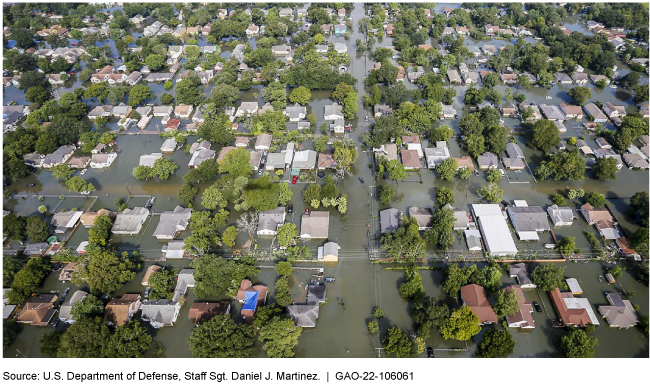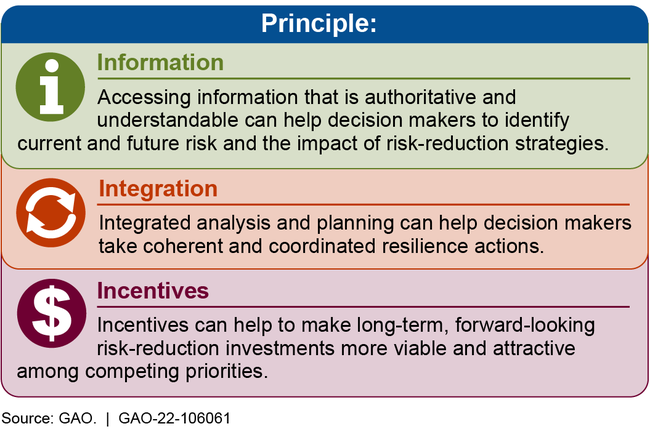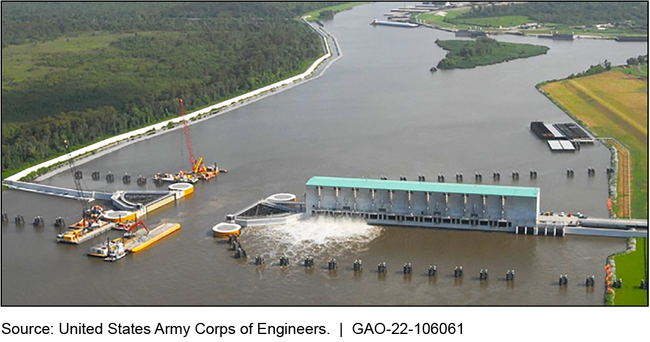Climate Change: Enhancing Federal Resilience
Fast Facts
Between FY 2015-2021, the federal government spent billions of dollars on disaster assistance. Disaster costs are projected to increase as certain extreme weather events like drought or floods become more frequent and intense due to climate change.
Enhancing the government's climate resilience—planning and preparation for potential climate hazards—can help it reduce potential future losses.
We drew from several of our reports to highlight opportunities for improving federal climate resilience. For example, we have recommended ways to identify government-wide risks and help agencies address their own infrastructure and facilities.

Highlights
To reduce federal fiscal exposure to climate change, the federal government needs a cohesive, strategic approach, with strong leadership and the authority to manage risks.
The Big Picture
Between fiscal years 2015 and 2021, selected appropriations for disaster assistance totaled $315 billion. Disaster costs are projected to increase as certain extreme weather events like drought or extreme rainfall become more frequent and intense because of climate change, according to the U.S. Global Change Research Program and the National Academies of Sciences, Engineering, and Medicine.
Limiting the Federal Government’s Fiscal Exposure by Better Managing Climate Change Risks has been on GAO’s High Risk List since 2013. This list identifies government operations that, among other things, need transformation to address effectiveness challenges. Managing climate change is on the list in part because of concerns about the increasing costs of disaster response and recovery efforts.
We identified five areas in which government-wide action is needed to reduce federal fiscal exposure to climate change. These areas include the federal government’s roles as (1) insurer of property and crops, (2) provider of disaster aid, (3) owner or operator of infrastructure, (4) leader of a strategic plan to coordinate federal efforts, and (5) provider of data and technical assistance to decision makers.
Federal fiscal exposure to climate change can be limited by enhancing climate resilience—that is, taking actions to reduce potential future losses by planning and preparing for potential climate hazards.
What GAO’s Work Shows
Congress and federal agencies can enhance climate resilience by pursuing opportunities related to the three guiding principles of GAO’s Disaster Resilience Framework—information, integration, and incentives.
GAO's Disaster Resilience Framework Principles

GAO has made numerous recommendations related to these principles. The examples highlighted below have not been addressed as of September 2022.
1. Information
Congress and federal agencies can help decision makers access climate information that is authoritative and understandable to identify current and future risks and the impact of risk-reduction strategies. A government-wide approach is needed to provide decision makers with the best available climate-related information.
We recommended:
- Designating a federal entity to develop and update climate information and to create a national climate information system
The federal government also needs a comprehensive approach to improve the resilience of the facilities it owns and operates and the land it manages.
We recommended:
- Incorporating climate resilience into agency infrastructure and facility planning, and natural hazards and climate change into agency risk management programs
- Working with relevant professional associations to incorporate climate change information into structural design standards
2. Integration
Congress and federal agencies can help decision makers integrate analysis and planning to take coordinated action to enhance climate resilience.
We recommended:
- Developing a strategic plan—with clear priorities, roles, and responsibilities—to guide the nation’s efforts to adapt to climate change
- Using information on potential economic effects from climate change to help identify significant climate risks and to craft appropriate federal responses
In some instances, congressional action is necessary to enable the federal government to invest in projects to enhance climate resilience and help communities prepare for climate change.
We also suggested that Congress consider:
- Establishing a federal organizational arrangement to periodically identify and prioritize climate resilience projects for federal investment
- Establishing a pilot program on climate migration to identify and provide assistance to for communities interested in relocation as a climate resilience strategy
Federal infrastructure projects, like this system in New Orleans, help protect against coastal storms and flooding

3. Incentives
Congress and federal agencies can enhance federal climate resilience by making long-term, forward-looking risk-reduction investments more viable and attractive among competing priorities.
We suggested that Congress consider:
- Requiring incorporation of climate resilience into the planning of all drinking water and wastewater projects that receive federal financial assistance
Challenges and Opportunities
The federal government faces increasing fiscal exposure from climate change, in part because of the complicated crosscutting nature of the issue. GAO’s work shows that opportunities exist for the federal government to develop an approach to manage climate change risks by building resilience into every federal program. In this regard, Congress has taken some actions, like creating programs for water, wastewater, transportation, and electric grid infrastructure resilience projects, in the Infrastructure Investment and Jobs Act.
More from GAO’s Portfolio
Climate Risks to National Security: GAO-22-105830
For more information, contact J. Alfredo Gomez at (202) 512-3841 or GomezJ@gao.gov.
